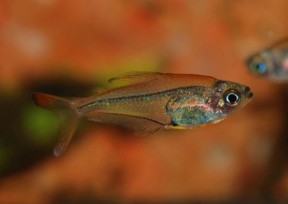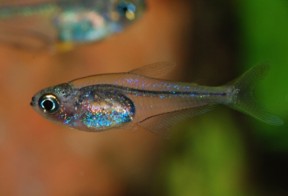Trochilocharax ornatus
Hummingbird Tetra
Etymology
Trochilocharax: from the Greek trochilos, meaning ‘little bird’, and later used specifically to refer to a family of hummingbirds, plus the generic name Charax.
ornatus: from the Latin ornare meaning ‘to adorn or decorate’.
Classification
Order: Characiformes Family: Characidae
Distribution
Unclear with type locality given as ‘Loreto, Peru’ because the type series was taken from an aquarium import deriving from Iquitos, northwestern (Amazonian) Peru.
In the description Zarske (2010) states that there is conflicting information to the origin of the fish in the trade, with some stating it to be collected from a blackwater tributary of the río Ampiyacu near Pebas while others claim that it’s native to the rio Nanay near Iquitos.
Habitat
Said to be an inhabitant of blackwater environments with further details unconfirmed, although it presumably inhabits minor forest streams and tributaries rather than larger river channels.
In the area around Iquitos such habitats typically contain clear, tannin-stained, acidic blackwater with negligible hardness and conductivity.
Substrates may be composed of sand or mud with lots of submerged fallen branches and tree roots, plus thick beds of leaf litter.
Much of the rainforest floor in Loreto region is flooded for part of the year and it may therefore also occur in these indundated zones.
Other fishes occurring in this kind of habitat include Nannostomus, Copella, Rivulus and Apistogramma species.
Maximum Standard Length
The largest specimen known measured 17.0 mm.
Aquarium SizeTop ↑
Surface dimensions of 45 ∗ 30 cm or equivalent should be the minimum considered for long-term care although smaller aquaria can be used for breeding.
Maintenance
Best-maintained in a well-structured set-up, ideally comprising a sandy substrate plus some driftwood roots and branches.
The addition of dried leaf litter further emphasises the natural feel and as well as offering additional cover for the fish brings with it the growth of microbe colonies as decomposition occurs.
These can provide a valuable secondary food source for fry and the tannins and other chemicals released by the decaying leaves are also considered beneficial for fishes from blackwater environments. Alder cones may also be used for the latter purpose.
This species seems to do best under fairly dim lighting. You can add aquatic plant species that can survive under such conditions such as Microsorum, Taxiphyllum or Cryptocoryne spp., while floating vegetation, especially Ceratopteris spp., is also useful.
For breeding purposes acidic conditions with negligible carbonate hardness and very low general hardness are required so a reverse osmosis unit or other method of obtaining soft water may need to be employed, and this can be further acidified using phosphoric acid or similar if necessary.
There is no need to use natural peat, the collection of which is both unsustainable and environmentally-destructive.
It goes without saying that this species is sensitive to fluctuating organic wastes and should never be introduced to biologically-immature aquaria.
Water Conditions
Temperature: 20 – 28 °C
pH: 4.0 – 6.5
Hardness: 18 – 143 ppm
Diet
Probably a micropredator feeding on tiny invertebrates and other zooplankton in nature.
In the aquarium it will accept dried foods of a suitable size but should also be offered daily meals of small live and frozen fare such as Artemia nauplii, Daphnia, Moina, grindal worm, etc.
Behaviour and CompatibilityTop ↑
Peaceful with other species but does not make an ideal community fish due to its small size and somewhat specialised requirements
Ideally it should be maintained alone or at most with diminutive, non-aggressive characids and smaller callichthyid or loricariid catfishes.
It also makes an ideal dither fish for Apistogramma spp. and other dwarf cichlids since it tends to inhabit the middle-to-upper regions of the tank.
Though gregarious by nature it’s a shoaling rather than schooling species with territorial rival males sparring on a regular basis.
8-10 specimens should be the minimum purchase since the fish will be less shy and display more interesting behaviour.
Sexual Dimorphism
Adult males are larger, more intensely-coloured and develop extended fins compared with females, plus they possess a pouch scale on the caudal peduncle.
Sexually mature females may appear rounder-bodied than males, especially when gravid.
Reproduction
Has been achieved and in a properly-structured, mature aquarium it’s possible that small numbers of fry may start to appear without intervention.
It apparently practices internal fertilisation with both males and females having distinctive genital papillae, but few details seem to be available.
NotesTop ↑
This species is not often available and is much sought after in the aquarium hobby where it’s been traded as ‘crystal rainbow tetra’ and ‘orange-tailed glass tetra’.
It’s also been referred to as a Heterocharax or Tyttocharax species in the past.
It’s currently the only member of its genus which is separated from other characid genera by the following combination of characters: body scaleless (naked) except in adult males which possess a pouch scale at the base of the caudal-fin (but not on the fin itself); possession of 2 spinous and 7 soft dorsal-fin rays; 4 spinous and 22-24 soft anal-fin rays; anal-fin rays 4-10 with a relatively large anterior hook, other fins without hooks; maxilla long and narrow with 5-8 conical teeth on the anterior portion; premaxilla and anterior portion of lower jaw with irregularly-arranged conical teeth partly protruding from the mouth; 34-35 (4+8+22-23) vertebrae.
The pouch scale in males is formed from 17-21 vertically-orientated radii and covers a convex structure which may or may not be a pheromone-producing gland.
Trochilocharax is included in the putative subfamily Stevardiinae with Zarske (2010) also creating the nominal tribe Trochilocharacini for it although its closer relationships within the family Characidae remain unclear.
Characiformes is among the most diverse orders of freshwater fishes currently including close to 2000 valid species distributed among 19 families.
This tremendous taxonomical and morphological diversity has historically impaired the ability of researchers to resolve their genetic relationships with many genera remaining incertae sedis.
A further limiting factor has been that in many cases exhaustive study of these on an individual basis is the only way to resolve such problems.
Modern molecular phylogenetic techniques have allowed some headway, though, although few of them include members of the subfamily Stevardiinae such as T. ornatus.
Oliveira et al. (2011) concluded that the family Characidae comprises three large clades, plus the genus Spintherobolus which was recovered as sister to all other characids.
These results are partially similar to those of earlier authors such as Malabarba and Weitzman (2003) who considered the Stevardiinae to form part of their clade ‘A’ alongside the subfamily Glandulocaudinae plus some other genera.
Menezes and Weitzman (2009) also consider the Stevardiinae and Glandulocaudinae to represent distinct subfamilies based on their study of morphological characters although the majority of recent molecular analyses have recommended that the Stevardiinae be expanded to include the monophyletic Glandulocaudinae plus all other members of clade ‘A’ (Miranda, 2009) and the species Markiana nigripinnis (Oliveira et al., 2011).
References
- Zarske, A., 2010 - Vertebrate Zoology 60(2): 75-98
Der Kolibrisalmler - Trochilocharax ornatus gen. et spec. nov. - ein neuer Salmler aus Peru (Teleostei: Characiformes: Characidae). - Calcagnotto, D., S. A. Schaefer, and R. DeSalle, 2005 - Molecular Phylogenetics and Evolution 36(1): 135-153
Relationships among characiform fishes inferred from analysis of nuclear and mitochondrial gene sequences. - Menezes, N. A. and S. H. Weitzman, 2009 - Neotropical Ichthyology 7(3): 295-370
Systematics of the Neotropical fish subfamily Glandulocaudinae (Teleostei: Characiformes: Characidae). - Mirande, J. M., 2009 - Cladistics 25(1): 1-40
Weighted parsimony phylogeny of the family Characidae (Teleostei: Characiformes). - Oliveira, C. A., G. S. Avellino, K. T. Abe, T. C. Mariguela, R. C. Benine, G. Orti, R. P. Vari, and R. M. Corrêa e Castro, 2011 - BMC Evolutionary Biology 11(1): 275-300
Phylogenetic relationships within the speciose family Characidae (Teleostei: Ostariophysi: Characiformes) based on multilocus analysis and extensive ingroup sampling.



